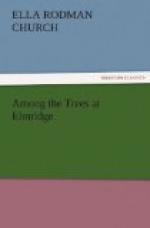[Illustration: MALE CATKIN OF THE OAK.]
[Illustration: THE OAK]
“The white oak is the handsomest species, and takes its name from the very light color of the bark on the trunk, by which it is easily known. The leaves are long in proportion to the width and deeply divided into lobes, of which there are three or four on each side. There is a great variety in the shape of oak-leaves, those of our white oak being long and slender, while the red oak has very broad ones, and the foliage of the scarlet oak is almost skeleton-like. The chestnut oak has leaves almost exactly like those of the chestnut. The acorns of the different varieties, too, differ in size and shape.
[Illustration: WHITE-OAK LEAF.]
“There is so much to be said of the oak,” continued Miss Harson, “it is such an ancient and venerable tree and has so many stories attached to it, that it is not easy to begin an account of it. The blossoms, perhaps, will be the best starting-point: and I should like to have you examine this branch and tell me if you see any difference in the blossoms.”
“They are nearly all alike,” said Malcolm, “but here at the ends of the twigs are one or two that look like buds."’
“That is just what I wanted you to notice,” replied his governess, “for the flowers are of two kinds, one bearing the stamens, and the other the pistils. The flowers that bear the stamens grow on loose scaly catkins, as you may see in this branch. Those with the pistils are also in catkins, but very small, like a bud. The bud spreads into a little branchlet and bears the flowers at the tip. The calyx is not seen at first; it is a mere membrane covering the ovary. By degrees the ovary swells into the acorn and the membrane becomes part of the shell.”
“I like acorns,” said little Edith, “they’re so nice to play with.”
“But they’re not nice to eat,” said Clara.
[Illustration: SQUIRREL AND ACORN]
“Some animals think they are,” continued Miss Harson. “If you should come here in October, you would find the squirrels feasting on them. In old times in England the oaks were valued highly on account of their acorns, and great herds of swine were driven into the forests to feed upon them. In the time of the Saxons a crop of acorns often formed a part of the dowry bestowed upon the Saxon queens, and the king himself would be glad to accept a gift or grant of acorns; and the failure of the crop would be considered as a kind of famine. In those days laws were made to protect the oaks from being felled or injured, and a man who cut down a tree under the shadow of which thirty hogs could stand was fined three pounds. The herds of swine were placed under the care of a swineherd, whose sole employment was to keep them together, and they formed a staple part of the riches of the country. But when the Norman kings began to rule, they brought with them a passionate love of hunting and took possession of the forests as preserves for their favorite sport. The herds of swine were forbidden to roam about as heretofore, and their owners were reduced to poverty in consequence.”




